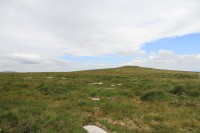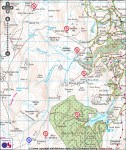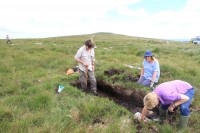 A previously unknown stone circle has been found on Dartmoor, the first new stone circle discovery in a hundred years. There are 30 stones, all of them now recumbent although packing stones found at the base of some of them indicate they were upright originally, in a circle 32 meters (105 feet) in diameter. One more stone lies just outside the circle and was built into an enclosure wall in more recent history. Radiocarbon dating of the peat underneath the stones found that they fell about 4,000 years ago. That means there’s a chance they could have been erected before Stonehenge which was built between 3,000 and 2,000 B.C.
A previously unknown stone circle has been found on Dartmoor, the first new stone circle discovery in a hundred years. There are 30 stones, all of them now recumbent although packing stones found at the base of some of them indicate they were upright originally, in a circle 32 meters (105 feet) in diameter. One more stone lies just outside the circle and was built into an enclosure wall in more recent history. Radiocarbon dating of the peat underneath the stones found that they fell about 4,000 years ago. That means there’s a chance they could have been erected before Stonehenge which was built between 3,000 and 2,000 B.C.
At 525 meters (1722 feet) above sea level, it is the highest stone circle in southern England and would have dominated the landscape when the stones were still vertical. It is located 300 meters (984 feet) southwest of Sittaford Tor, one of Dartmoor’s hills topped with granite boulders, which was probably the source for the stones in the circle. The fact that the stones are of relatively uniform size and shape suggests they were deliberately selected and carried down the hill to the site.
 The location of the circle is particularly significant because it fits perfectly in a crescent pattern created by seven other stone circles on the northeastern edge of Dartmoor. The newly discovered circle is the southernmost of the eight, just west of the first and northernmost circle, the one at Little Hound Tor. The author of the excellent Prehistoric Dartmoor Walks website has created a map of the arc. Archaeologists believe this pattern is deliberate, evidence of large scale planning and communication between the late Stone Age, early Bronze Age communities living on Dartmoor four to five thousand years ago.
The location of the circle is particularly significant because it fits perfectly in a crescent pattern created by seven other stone circles on the northeastern edge of Dartmoor. The newly discovered circle is the southernmost of the eight, just west of the first and northernmost circle, the one at Little Hound Tor. The author of the excellent Prehistoric Dartmoor Walks website has created a map of the arc. Archaeologists believe this pattern is deliberate, evidence of large scale planning and communication between the late Stone Age, early Bronze Age communities living on Dartmoor four to five thousand years ago.
 The circle was discovered by Dartmoor native and stained glass artist Alan Endacott in 2007 after a controlled burn of the undergrowth exposed the stones long hidden beneath the brush. The find was not announced until last year and archaeological explorations are still in the early stages. Since this is the first stone circle found in generations, it gives archaeologists the first chance to study a pristine site using modern technology.
The circle was discovered by Dartmoor native and stained glass artist Alan Endacott in 2007 after a controlled burn of the undergrowth exposed the stones long hidden beneath the brush. The find was not announced until last year and archaeological explorations are still in the early stages. Since this is the first stone circle found in generations, it gives archaeologists the first chance to study a pristine site using modern technology.
Jane Marchand, Senior Archaeologist, Dartmoor National Park said:
“Its discovery is providing an opportunity for investigation using the very latest archaeological scientific methods to provide long awaited insights into the chronology, construction and the purpose of these most elusive and iconic of Dartmoor’s prehistoric monuments.” […]Although the full results of the geophysical surveys are not back yet, preliminary results have revealed a wide ditch running in a linear fashion just outside the eastern side of the circle. Further investigation is planned later this summer.